CCNPv8 ENCOR (Version 8.0) – BGP Exam
1. What TCP port is used by BGP to exchange messages between routers?
- 443
- 58
- 179
- 22
2. Refer to the exhibit. Autonomous system 65500 is routing traffic between two external BGP autonomous systems, autonomous system 65200 and autonomous system 65100. Synchronization is disabled on BGP in autonomous system 65500. Which routers should have IBGP peer relationships for routing between autonomous system 65200 and autonomous system 65100 to work properly?
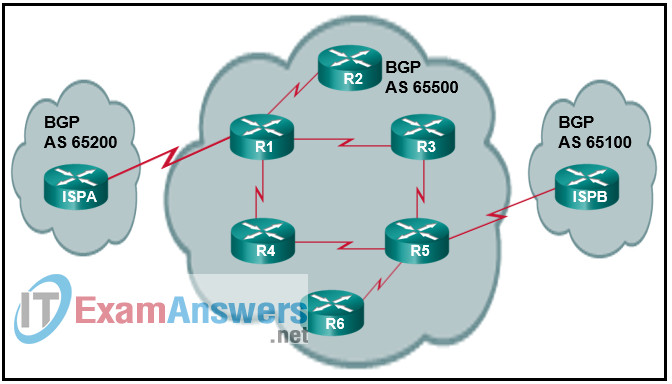
- ISPA, R1, R5, and ISPB
- R1, R3, and R4
- R1 and R5
- R1, R3, R4, and R5
3. What type of BGP message precedes the successful formation of a BGP peering session?
- keepalive
- established
- withdraw
- open
- update
4. Question as presented: Match the values to AFI and SAFI extensions supported by MBGP. (Not all options are used.)
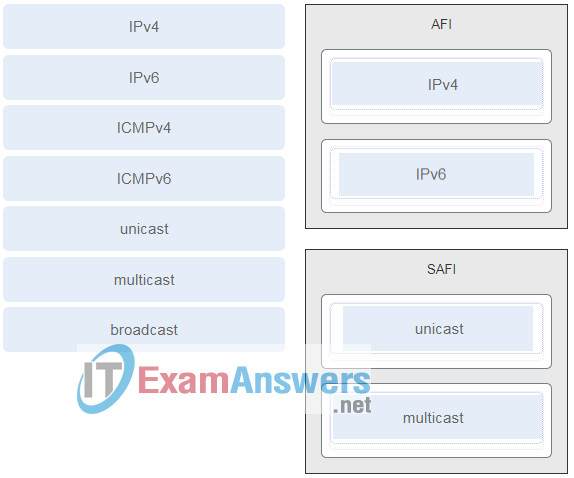
5. What is the order in determining the BGP router ID?
- statically defined, the highest IP address of any active interfaces, and the highest IP address of any active loopback interfaces
- statically defined, the highest IP address of any active loopback interfaces, and the highest IP address of any active interfaces
- the highest IP address of any active interfaces, statically defined, and the highest IP address of any active loopback interfaces
- the highest IP address of any active loopback interfaces, statically defined, and the highest IP address of any active interfaces
6. Refer to the exhibit. A network administrator is configuring BGP on a router. Which configuration step is needed in order to establish the BGP session with the neighbor router?
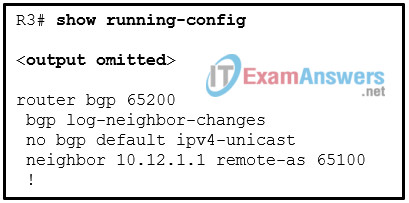
- Configure the keepalive timer.
- Initialize and activate the address family.
- Advertise the networks attached to the router.
- Restart the BGP process.
7. Refer to the exhibit. Which two configurations will allow router R1 to establish a neighbor relationship with router R2? (Choose two.)

R1(config)# router bgp 65002
R1(config-router)# network 192.168.20.0
R1(config-router)# neighbor 209.165.200.225 remote-as 65001
R2(config)# router bgp 65002
R2(config-router)# network 192.168.10.0
R1(config)# router bgp 65001
R1(config-router)# network 192.168.20.0
R1(config)# router bgp 65001
R1(config-router)# network 192.168.10.0
R1(config-router)# neighbor 209.165.200.226 remote-as 65002
R2(config)# router bgp 65002
R2(config-router)# network 192.168.20.0
R2(config-router)# neighbor 209.165.200.225 remote-as 65001
R2(config)# router bgp 65002
R2(config-router)# network 192.168.10.0
R2(config-router)# neighbor 209.165.200.226 remote-as 65002
8. Which BGP routers will become peers and share routing information?
- BGP routers that are configured with the same network command
- BGP routers that are configured with the same peer command
- BGP routers that are configured with the neighbor command
- BGP routers that share routing information with all routers in the same AS by default
9. Which two statements describe the configuration differences when MP-BGP is applied using the IPv6 protocol compared to IPv4 protocol? (Choose two.)
- The IPv6 address family must be initialized and the neighbor activated.
- Routers with only IPv6 addressing must have the BGP RID statically defined.
- IPv4 addresses cannot be used to define a BGP RID.
- IPv6 uses multicast to establish neighbor sessions.
- Routers with only IPv6 addressing must use AS numbers beyond 65535.
10. A network administrator is configuring IPv6 route summarization on a BGP router. The objective is to aggregate the IPv6 networks from 2001:db8:0:0::/64 to 2001:db8:0:35::/64 into a single summary route. Which aggregation command should be used for the task?
- aggregate-address 2001:db8::/60 summary-only
- aggregate-address 2001:db8::/61 summary-only
- aggregate-address 2001:db8::/58 summary-only
- aggregate-address 2001:db8::/59 summary-only
11. Refer to the exhibit. What is used to exchange routing information between routers within each AS?
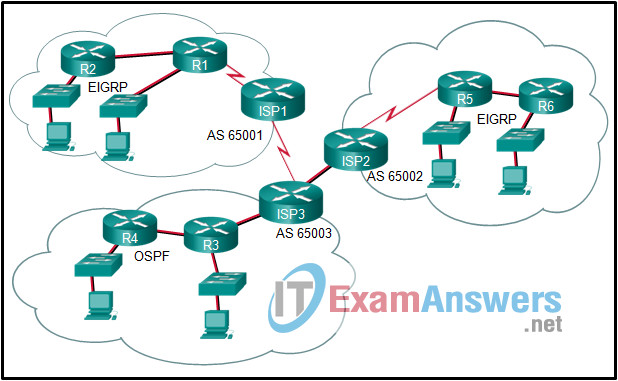
- default routing
- IGP routing protocols
- EGP routing protocols
- static routing
12. Refer to the exhibit. A network administrator is configuring BGP on a router. What network layer protocol and function are enabled for the BGP session?
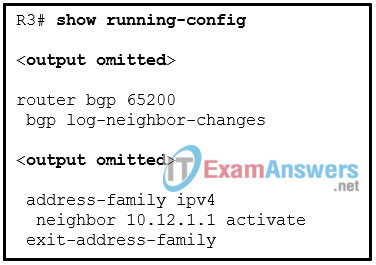
- IPv4 protocol with TCP connections.
- IPv4 protocol with all the functions.
- IPv4 protocol with unicast communication.
- IPv4 protocol with both unicast and multicast communications.
13. Which BGP state is the one where BGP initiates the TCP connection and sends an Open message to the sender?
- Passive
- Connect
- OpenSent
- Established
14. Which BGP attribute includes a complete list of all the ASNs that the prefix advertisement has traversed from its source AS?
- Local Preference (LocPrf)
- Multiple-exit discriminator (MED)
- Weight
- AS_Path
15. Refer to the exhibit. For which autonomous system would running BGP not be appropriate?
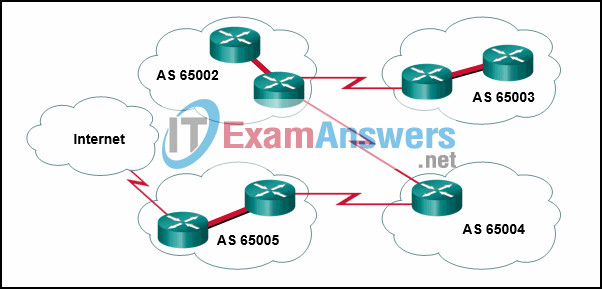
- 65004
- 65005
- 65003
- 65002
16. A company is deploying BGP multihoming to provide internet connection redundancy. Which method can be used to avoid the internet transit routing situation?
- deploying iBGP routing in all routers within the local AS
- ensuring that no IGP session is running on the local BGP routers
- designating a data center or a specific location to handle the internet transit traffic
- applying outbound BGP route policies that only allow for local BGP routes to be advertised
17. Refer to the exhibit. Which statement describes the condition when the BGP route-map TEST permit 40 command is processed and what is the result of processing?
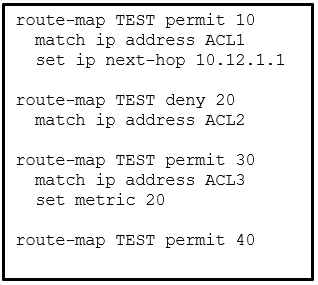
- Only networks that do not match ACL3 will match and be allowed.
- Incoming networks that match ACL1, ACL2, and ACL3 will match and be allowed.
- All incoming networks that do not match ACL1, ACL2, and ACL3 will match, but will be dropped because no action is specified.
- All incoming networks that do not match ACL1, ACL2, and ACL3 will match and be allowed.
18. A company is deploying BGP multihoming to provide network connection redundancy for several branch locations. One of the network design objectives is to provide deterministic routing among company locations during failover by providing a specific location to handle branch transit traffic. Which two design criteria should be applied to the specific facility? (Choose two.)
- The bandwidth can be sized according to the traffic needs.
- The facility should be in a central place from all company locations.
- OSPF is the preferred IGP for the facility.
- The routing pattern is bidirectional and predictable.
- BGP route policies should apply to only allow for local BGP routes to be advertised.
19. A network administrator is configuring a prefix list with the ip prefix-list command. What is the best practice in dealing with the sequence number in creating a prefix list?
- Sequence numbers should leave enough space to accommodate additional entries.
- Sequence numbers should start with 1.
- Sequence numbers should be no higher than 100.
- Sequence numbers should be incremented by 2.
20. A network administrator is configuring a prefix list with the command
ipv6 prefix-list IPV6-1 seq 5 permit 2001:db8:abcd:30::/60 ge 61 le 63
Which two networks match the prefix match specification? (Choose two.)
- 2001:db8:abcd:30::/60
- 2001:db8:abcd:34::/62
- 2001:db8:abcd:20::/62
- 2001:db8:abcd:36::/63
- 2001:db8:abcd:60::/64
21. Question as presented: Match the route map component to the description. (Not all options are used.)
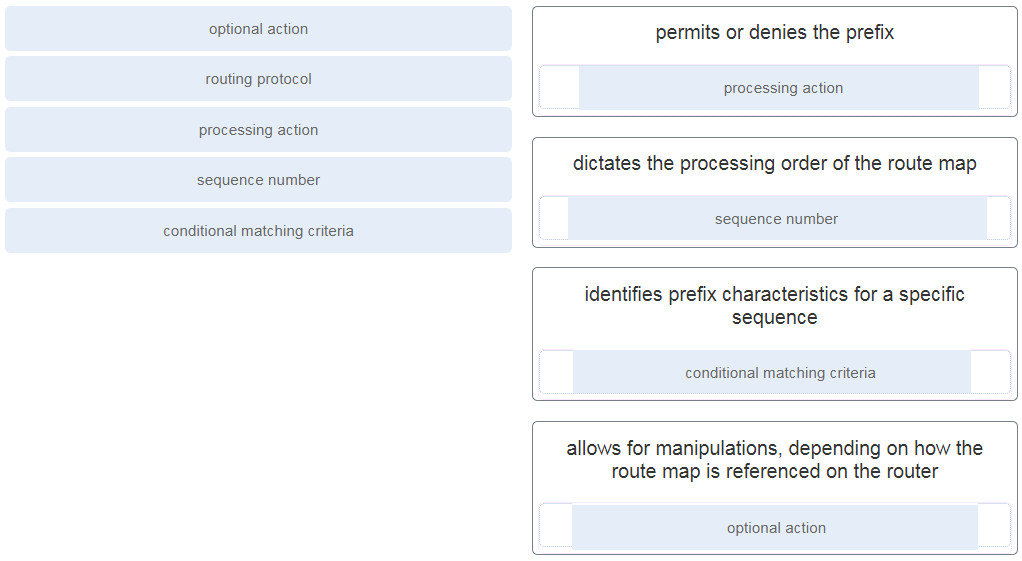
22. Refer to the exhibit. Considering the route map configuration for BGP, which statement describes the condition for a network prefix to match the route map TEST ?

- The network prefix needs to match both ACL1 and ACL2 independently of the processing action.
- If the processing action is permit, the network prefix needs to match either ACL1 or ACL2.
- The network prefix needs to match either ACL1 or ACL2 independently of the processing action.
- If the processing action is deny, the network prefix needs to match both ACL1 and ACL2.
23. Which BGP state is the one where BGP waits for a KEEPALIVE or NOTIFICATION message from a neighbor so that the BGP session can be moved to Established?
- Attempt
- Down
- OpenConfirm
- Init
24. Which three statements describe the weight attribute for BGP? (Choose three.)
- It is a Cisco-defined attribute.
- It is a nontransitive attribute that uses a 32-bit value called metric.
- It is not advertised to other routers.
- It is a 16-bit value assigned locally on the router.
- It is not advertised between eBGP peers and is typically used to influence the next-hop address for outbound traffic.
- It is a well-known discretionary path attribute and is included with path advertisements throughout an AS.
25. Which BGP attribute can be configured on IBGP speakers so they will choose a desired path out of the autonomous system to an outside network?
- local preference
- next hop
- MED
- aggregate
26. A network administrator is configuring a prefix list to match networks for BGP route filtering. Which two networks match the prefix match specification 10.224.0.0/12 ge 24 le 28 ? (Choose two.)
- 10.240.10.0/24
- 10.224.10.0/12
- 10.230.15.0/24
- 10.239.255.240/28
- 10.192.20.0/26
27. Refer to the exhibit. A network administrator is troubleshooting BGP configuration and wants to display only routes that originated in AS 40. Which regular expression should the administrator use in the command show bgp ipv4 unicast regex regex-pattern ?
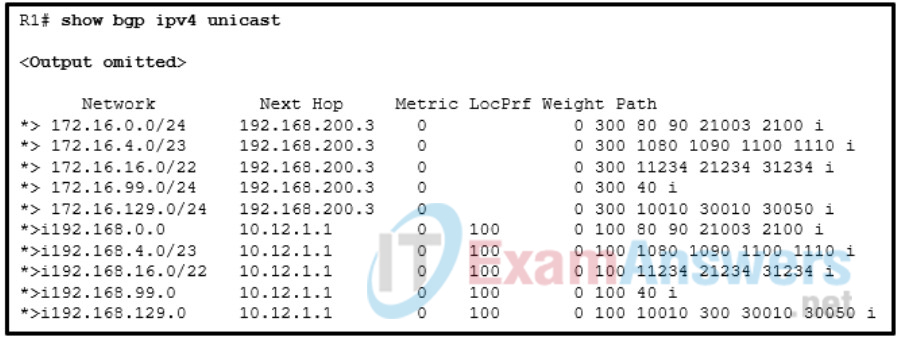
- show bgp ipv4 unicast regex ^40_
- show bgp ipv4 unicast regex *40_
- show bgp ipv4 unicast regex _40$ ????
- show bgp ipv4 unicast regex .40.
28. Which two statements describe private BGP communities? (Choose two.)
- A private BGP community requires a route map configuration.
- Private BGP communities are used to signify no transit networks.
- An organization needs to register for a private BGP community.
- Private BGP communities are within the range of 0xFFFF0000 to 0xFFFFFFFF.
- A private BGP community uses the first 16 bits to represent its AS and the second 16 bits to represent a pattern.
29. Refer to the exhibit. Given the above configuration commands, which two statements are true? (Choose two.)

- RTA will set the atomic aggregate attribute to false.
- RTA will set the atomic aggregate attribute to true.
- RTA will send the supernet route as well as all other specific BGP routes that belong to that supernet.
- RTA will create the supernet route even if no other specific routes belonging to the supernet are in the route table.
- RTA will send the supernet route and suppress the more specific routes known to BGP.
30. Refer to the exhibit. A network administrator issues the show bgp ipv4 unicast command to check the routes in the BGP table. What does the indication of 0.0.0.0 under Next Hop mean?

- The route is the best route for the network prefix.
- The route is originated from a connected network to the router.
- The route is learned through a static route.
- The route is learned through IGP.
31. A network administrator is configuring route summarization for received routes before advertising to the next peer with the commands:
R1(config)# router bgp 65500 R1(config-router)# aggregate-address 172.16.0.0 255.255.240.0 as-set summary-only R1(config-router)# end
How will the aggregate route be advertised after the commands are entered?
- The aggregate route will be advertised together with the smaller component network prefixes.
- The advertised aggregate route will increase the hop counts as it indicates multiple autonomous systems.
- The aggregate route will be advertised as an atomic aggregate route.
- The aggregate route will be advertised with previous BGP path information.
32. Which BGP state is the one where an Open message has been sent from the originating router and is awaiting an Open message from the other router?
- ExStart
- OpenSent
- 2-way
- Passive
33. Refer to the exhibit. A network administrator is configuring BGP route filtering on R1. The objective is to advertise only locally originated routes to its neighbor to avoid undesirable transit connectivity. Which AS path ACL should the administrator configure?
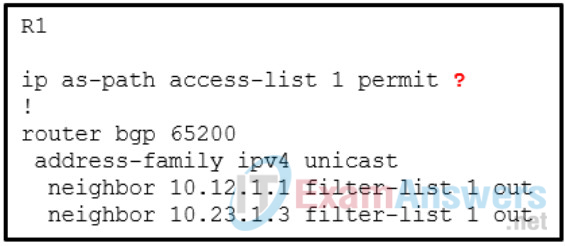
- ip as-path access-list 1 permit [^$]
- ip as-path access-list 1 permit *$
- ip as-path access-list 1 permit ^$
- ip as-path access-list 1 permit _$
34. A network administrator is configuring an ACL to match networks for BGP route filtering. The administrator creates an ACE permit ip 10.0.64.0 0.0.63.0 255.255.255.0 0.0.0.192 . Which two networks match the ACE? (Choose two.)
- 10.0.128.0/25
- 10.0.126.0/25
- 10.0.130.0/24
- 10.0.64.0/24
- 10.0.63.0/26
35. Refer to the exhibit. A network administrator is troubleshooting BGP configuration and wants to display only routes with AS 300 being the first AS in the AS_Path value. Which regular expression should the administrator use in the command show bgp ipv4 unicast regex regex-pattern ?
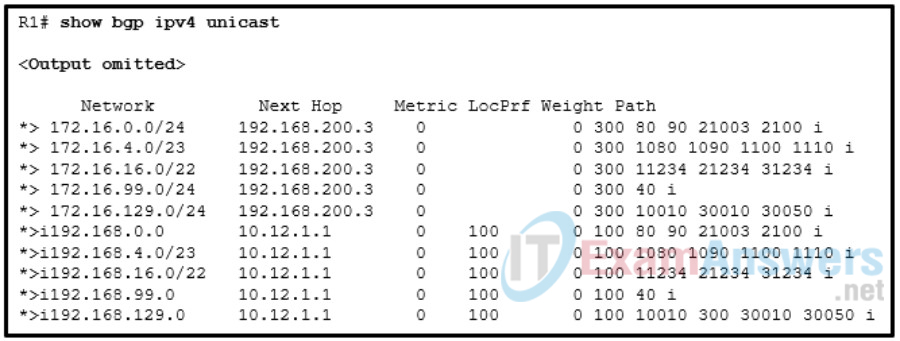
- show bgp ipv4 unicast regex $300
- show bgp ipv4 unicast regex .300.
- show bgp ipv4 unicast regex _300_
- show bgp ipv4 unicast regex ^300_
36. Which BGP message is sent when an error is detected with the BGP session causing the BGP connection to close?
- Notification
- Database description
- Query
- Reply
37. Which BGP attribute is used as a loop-prevention mechanism in BGP?
- Local Preference (LocPrf)
- Multiple-exit discriminator (MED)
- Origin
- AS_Path

Refer to the exhibit. A network administrator is troubleshooting BGP configuration and wants to display only routes that originated in AS 40. Which regular expression should the administrator use in the command show bgp ipv4 unicast regex regex-pattern ?
show bgp ipv4 unicast regex _40$ (correct)
Which two statements describe private BGP communities? (Choose two.)
A private BGP community requires a route map configuration.
A private BGP community uses the first 16 bits to represent its AS and the second 16 bits to represent a pattern.
Private BGP communities follow a convention where the first 16 bits represent the AS of the community organization, and the second 16 bits represent a pattern defined by the originating AS. A private BGP community pattern can vary from organization to organization, does not need to be registered, and can signify geographic locations for one AS while signifying a method of route advertisement in another AS. A private BGP community is set in a route map with the command set community bgpcommunity [ additive ].
Refer to the exhibit. Given the above configuration commands, which two statements are true? (Choose two.)
RTA will send the supernet route and suppress the more specific routes known to BGP.
RTA will set the atomic aggregate attribute to true.
those are the correct answers
Hi. I think in Q32 correct answer is:
(CCNP and CCIE Enterprise Core ENCOR 350-401 Official Cert Guide – page 250)
Hi. I think in Q27 correct answer is:
show bgp ipv4 unicast regex _40$
We can find same example in Cisco docs: https://www.ciscolive.com/c/dam/r/ciscolive/emea/docs/2019/pdf/BRKRST-3320.pdf
Ask is originated in AS 40, so AS Path must begin with “40 “. Correct answer is:
show bgp ipv4 unicast regex ^40_
No, the correct answer is:
show bgp ipv4 unicast regex _40$
because you want to see the originated AS, which is the last in the row
Added, thanks for your sharing!
43. Refer to the exhibit. A network administrator issues the show bgp ipv4 unicast command to check the routes in the BGP table. What does the indication of 0.0.0.0 under Next Hop mean?
Updated all, many thanks for your sharing!
44. A network administrator is configuring route summarization for received routes before advertising to the next peer with the commands:
How will the aggregate route be advertised after the commands are entered?
46. Refer to the exhibit. A network administrator is configuring BGP route filtering on R1. The objective is to advertise only locally originated routes to its neighbor to avoid undesirable transit connectivity. Which AS path ACL should the administrator configure?
47. A network administrator is configuring an ACL to match networks for BGP route filtering. The administrator creates an ACE permit ip 10.0.64.0 0.0.63.0 255.255.255.0 0.0.0.192 . Which two networks match the ACE? (Choose two.)
48. Refer to the exhibit. A network administrator is troubleshooting BGP configuration and wants to display only routes with AS 300 being the first AS in the AS_Path value. Which regular expression should the administrator use in the command show bgp ipv4 unicast regex regex-pattern ?
Refer to the exhibit. Given the above configuration commands, which two statements are true? (Choose two.)
I think it is incorrect because BGP aggregation roll says at least one of agg. routes must be in RIB.
Hi. RTA will not send suppress routes to other routers, only supernet. For example https://www.cisco.com/c/en/us/support/docs/ip/border-gateway-protocol-bgp/5441-aggregation.html
Router C has suppress routes, but send to D only supernet.
Sorry, i think you right. It seems i do mistake when write answer, because the chapter 100% passed.
I can confirm, the correct answers are:
Refer to the exhibit. A network administrator is troubleshooting BGP configuration and wants to display only routes that originated in AS 40. Which regular expression should the administrator use in the command show bgp ipv4 unicast regex regex-pattern ?
Added all, many thanks for sharing!
Which two statements describe private BGP communities? (Choose two.)